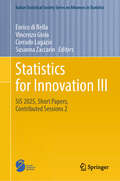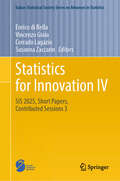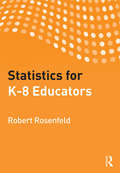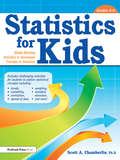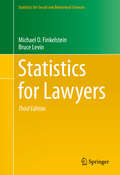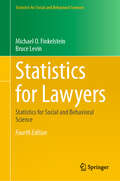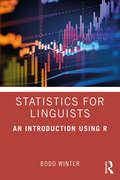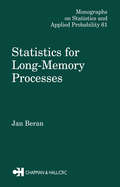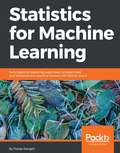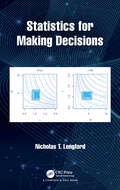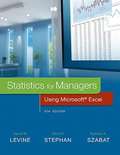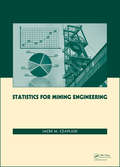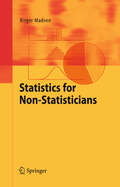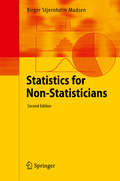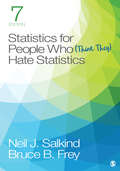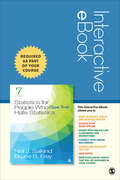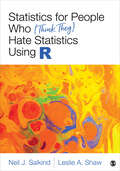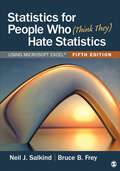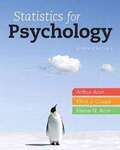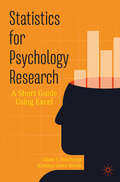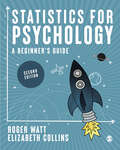- Table View
- List View
Statistics for Innovation III: SIS 2025, Short Papers, Contributed Sessions 2 (Italian Statistical Society Series on Advances in Statistics)
by Enrico Di Bella Vincenzo Gioia Corrado Lagazio Susanna ZaccarinThis book presents peer-reviewed short papers on methodological and applied statistical research presented at the Italian Statistical Society&’s international conference on &“Statistics for Innovation&”, SIS 2025, held in Genoa, Italy, June 16-18, 2025. It is the third of four volumes, featuring the second part of the contributions presented in the Contributed Sessions. Providing a comprehensive overview of innovations in modern statistical methods and applications, the volumes address a large number of topics of current interest, contributing to a rapid dissemination of quantitative methods for data analysis across the various fields of scientific research and social life. The volumes underpin the role of statistics and data science in fostering innovation in numerous fields, including business, industry, finance, technology, environment, health and medicine, official statistics, public policy, welfare, social issues and sustainable development. One of the aims of the Italian Statistical Society (SIS) is to promote scientific activities for the development of statistical sciences. Together with the biennial international Scientific Meeting, the intermediate international statistical conferences on a particular topic of interest represent the Society&’s most important events which bring together national and international researchers and professionals to exchange ideas and discuss recent advances and developments in theoretical and applied statistics.
Statistics for Innovation IV: SIS 2025, Short Papers, Contributed Sessions 3 (Italian Statistical Society Series on Advances in Statistics)
by Enrico Di Bella Vincenzo Gioia Corrado Lagazio Susanna ZaccarinThis book presents peer-reviewed short papers on methodological and applied statistical research presented at the Italian Statistical Society&’s international conference on &“Statistics for Innovation&”, SIS 2025, held in Genoa, Italy, June 16-18, 2025. It is the last of four volumes, featuring the third part of the contributions presented in the Contributed Sessions. Providing a comprehensive overview of innovations in modern statistical methods and applications, the volumes address a large number of topics of current interest, contributing to a rapid dissemination of quantitative methods for data analysis across the various fields of scientific research and social life. The volumes underpin the role of statistics and data science in fostering innovation in numerous fields, including business, industry, finance, technology, environment, health and medicine, official statistics, public policy, welfare, social issues and sustainable development. One of the aims of the Italian Statistical Society (SIS) is to promote scientific activities for the development of statistical sciences. Together with the biennial international Scientific Meeting, the intermediate international statistical conferences on a particular topic of interest represent the Society&’s most important events which bring together national and international researchers and professionals to exchange ideas and discuss recent advances and developments in theoretical and applied statistics.
Statistics for K-8 Educators
by Robert RosenfeldThis book offers an introduction to descriptive and inferential statistics tailored to the teaching and research needs of K-8 educators. Using statistics to tell a story, veteran teacher educator Robert Rosenfeld pushes readers away from simply performing a calculation to truly understanding the statistical concepts themselves. In addition to helping educators develop this statistical habit of mind, Rosenfeld also focuses on developing an understanding of the statistics in published research and on interpreting school data, which can be applied in school assessment and educational research. Features of this must-read resource include: Numerous exercises and activities throughout that are related specifically to the world of educators and are designed to foster conversation and small group discussion. Connections drawn between statistics and the regular mathematics curriculum to aid teachers who do classroom-based action research. A section covering the basic concepts of standardized tests, such as summative versus formative assessment, and standards-based versus norm-referenced tests. Accessibly written and conversational in tone, Statistics for K-8 Eductors provides the technical foundation to help teachers make good sense of quantitative information connected to their classrooms and to their schools.
Statistics for Kids: Model Eliciting Activities to Investigate Concepts in Statistics (Grades 4-6)
by Scott ChamberlinPerhaps the most useful and neglected content area of mathematics is statistics, especially for students in Grades 4-6. Couple that fact with the notion that mathematical modeling is an increasing emphasis in many standards, such as the Common Core State Standards for Mathematics and the NCTM standards, and the necessity for this topic is overdue. In this book, teachers will facilitate learning using model-eliciting activities (MEAs), problem-solving tasks created by mathematics educators to encourage students to investigate concepts in mathematics through the creation of mathematical models. Students will explore statistical concepts including trends, spread of data, standard deviation, variability, correlation, sampling, and more—all of which are designed around topics of interest to students. Grades 4-6
Statistics for Lawyers
by Michael O. Finkelstein Bruce LevinThis classic text, first published in 1990, is designed to introduce law students, law teachers, practitioners, and judges to the basic ideas of mathematical probability and statistics as they have been applied in the law. The third edition includes over twenty new sections, including the addition of timely topics, like New York City police stops, exonerations in death-sentence cases, projecting airline costs, and new material on various statistical techniques such as the randomized response survey technique, rare-events meta-analysis, competing risks, and negative binomial regression. The book consists of sections of exposition followed by real-world cases and case studies in which statistical data have played a role. The reader is asked to apply the theory to the facts, to calculate results (a hand calculator is sufficient), and to explore legal issues raised by quantitative findings. The authors' calculations and comments are given in the back of the book. As with previous editions, the cases and case studies reflect a broad variety of legal subjects, including antidiscrimination, mass torts, taxation, school finance, identification evidence, preventive detention, handwriting disputes, voting, environmental protection, antitrust, sampling for insurance audits, and the death penalty. A chapter on epidemiology was added in the second edition. In 1991, the first edition was selected by the University of Michigan Law Review as one of the important law books of the year.
Statistics for Lawyers: Statistics for Social and Behavioral Science (Statistics for Social and Behavioral Sciences #189)
by Michael O. Finkelstein Bruce LevinThis classic text, first published in 1990, is designed to introduce law students, law teachers, practitioners, and judges to the basic ideas of mathematical probability and statistics as they have been applied in the law. The fourth edition includes fourteen new sections, four inserts to the statistical text, and six new answer sections, on topics including the following: Use of prior probabilities after DNA database searches; Lipitor and diabetes; Harvard’s affirmative action practices in admissions; New York City garbage trucks; Tests of odds ratio homogeneity; Disparate impact of a pre-employment exam on minority applicants; Liraglutide and pancreatic cancer; Representative sampling; Reversals in death-penalty cases; Technology assisted review in e-discovery; Asbestos and colon cancer; Guilty pleas in the federal courts; The “financing secured” event study; and Average marginal effects. The book consists of sections of exposition followed by real-world cases and case studies in which statistical data have played a role. The reader is asked to apply the theory to the facts, to calculate results (a hand calculator is sufficient), and to explore legal issues raised by quantitative findings. The authors' calculations and comments are given in the back of the book. As with previous editions, the cases and case studies reflect a broad variety of legal subjects, including antidiscrimination, mass torts, taxation, school finance, identification evidence, preventive detention, handwriting disputes, voting, environmental protection, antitrust, sampling for insurance audits, and the death penalty.
Statistics for Linguists: An Introduction Using R
by Bodo WinterStatistics for Linguists: An Introduction Using R is the first statistics textbook on linear models for linguistics. The book covers simple uses of linear models through generalized models to more advanced approaches, maintaining its focus on conceptual issues and avoiding excessive mathematical details. It contains many applied examples using the R statistical programming environment. Written in an accessible tone and style, this text is the ideal main resource for graduate and advanced undergraduate students of Linguistics statistics courses as well as those in other fields, including Psychology, Cognitive Science, and Data Science.
Statistics for Long-Memory Processes (Chapman And Hall/crc Monographs On Statistics And Applied Probability Ser. #61)
by Jan BeranStatistical Methods for Long Term Memory Processes covers the diverse statistical methods and applications for data with long-range dependence. Presenting material that previously appeared only in journals, the author provides a concise and effective overview of probabilistic foundations, statistical methods, and applications. The material emphasizes basic principles and practical applications and provides an integrated perspective of both theory and practice. This book explores data sets from a wide range of disciplines, such as hydrology, climatology, telecommunications engineering, and high-precision physical measurement. The data sets are conveniently compiled in the index, and this allows readers to view statistical approaches in a practical context. Statistical Methods for Long Term Memory Processes also supplies S-PLUS programs for the major methods discussed. This feature allows the practitioner to apply long memory processes in daily data analysis. For newcomers to the area, the first three chapters provide the basic knowledge necessary for understanding the remainder of the material. To promote selective reading, the author presents the chapters independently. Combining essential methodologies with real-life applications, this outstanding volume is and indispensable reference for statisticians and scientists who analyze data with long-range dependence.
Statistics for Machine Learning
by Pratap DangetiBuild Machine Learning models with a sound statistical understanding. About This Book • Learn about the statistics behind powerful predictive models with p-value, ANOVA, and F- statistics. • Implement statistical computations programmatically for supervised and unsupervised learning through K-means clustering. • Master the statistical aspect of Machine Learning with the help of this example-rich guide to R and Python. Who This Book Is For This book is intended for developers with little to no background in statistics, who want to implement Machine Learning in their systems. Some programming knowledge in R or Python will be useful. What You Will Learn • Understand the Statistical and Machine Learning fundamentals necessary to build models • Understand the major differences and parallels between the statistical way and the Machine Learning way to solve problems • Learn how to prepare data and feed models by using the appropriate Machine Learning algorithms from the more-than-adequate R and Python packages • Analyze the results and tune the model appropriately to your own predictive goals • Understand the concepts of required statistics for Machine Learning • Introduce yourself to necessary fundamentals required for building supervised & unsupervised deep learning models • Learn reinforcement learning and its application in the field of artificial intelligence domain In Detail Complex statistics in Machine Learning worry a lot of developers. Knowing statistics helps you build strong Machine Learning models that are optimized for a given problem statement. This book will teach you all it takes to perform complex statistical computations required for Machine Learning. You will gain information on statistics behind supervised learning, unsupervised learning, reinforcement learning, and more. Understand the real-world examples that discuss the statistical side of Machine Learning and familiarize yourself with it. You will also design programs for performing tasks such as model, parameter fitting, regression, classification, density collection, and more. By the end of the book, you will have mastered the required statistics for Machine Learning and will be able to apply your new skills to any sort of industry problem. Style and approach This practical, step-by-step guide will give you an understanding of the Statistical and Machine Learning fundamentals you'll need to build models.
Statistics for Making Decisions
by Nicholas T. LongfordMaking decisions is a ubiquitous mental activity in our private and professional or public lives. It entails choosing one course of action from an available shortlist of options. Statistics for Making Decisions places decision making at the centre of statistical inference, proposing its theory as a new paradigm for statistical practice. The analysis in this paradigm is earnest about prior information and the consequences of the various kinds of errors that may be committed. Its conclusion is a course of action tailored to the perspective of the specific client or sponsor of the analysis. The author’s intention is a wholesale replacement of hypothesis testing, indicting it with the argument that it has no means of incorporating the consequences of errors which self-evidently matter to the client. The volume appeals to the analyst who deals with the simplest statistical problems of comparing two samples (which one has a greater mean or variance), or deciding whether a parameter is positive or negative. It combines highlighting the deficiencies of hypothesis testing with promoting a principled solution based on the idea of a currency for error, of which we want to spend as little as possible. This is implemented by selecting the option for which the expected loss is smallest (the Bayes rule). The price to pay is the need for a more detailed description of the options, and eliciting and quantifying the consequences (ramifications) of the errors. This is what our clients do informally and often inexpertly after receiving outputs of the analysis in an established format, such as the verdict of a hypothesis test or an estimate and its standard error. As a scientific discipline and profession, statistics has a potential to do this much better and deliver to the client a more complete and more relevant product. Nicholas T. Longford is a senior statistician at Imperial College, London, specialising in statistical methods for neonatal medicine. His interests include causal analysis of observational studies, decision theory, and the contest of modelling and design in data analysis. His longer-term appointments in the past include Educational Testing Service, Princeton, NJ, USA, de Montfort University, Leicester, England, and directorship of SNTL, a statistics research and consulting company. He is the author of over 100 journal articles and six other monographs on a variety of topics in applied statistics.
Statistics for Managers Using Microsoft Excel
by David Levine David Stephan Kathryn Szabat<p>For undergraduate business statistics courses. Analyzing the Data Applicable to Business. This text is the gold standard for learning how to use Microsoft Excel® in business statistics, helping students gain the understanding they need to be successful in their careers. The authors present statistics in the context of specific business fields; full chapters on business analytics further prepare students for success in their professions. Current data throughout the text lets students practice analyzing the types of data they will see in their professions. The friendly writing style include tips throughout to encourage learning. <p>The book also integrates PHStat, an add-in that bolsters the statistical functions of Excel.</p>
Statistics for Mathematicians
by Victor M. PanaretosThis textbook provides a coherent introduction to the main concepts andmethods of one-parameter statistical inference. Intended for students ofMathematics taking their first course in Statistics, the focus is on Statisticsfor Mathematicians rather than on Mathematical Statistics. The goal is notto focus on the mathematical/theoretical aspects of the subject, but rather toprovide an introduction to the subject tailored to the mindset and tastes ofMathematics students, who are sometimes turned off by the informal nature ofStatistics courses. This book can be used as the basis for an elementary semester-longfirst course on Statistics with a firm sense of direction that does notsacrifice rigor. The deeper goal of the text is to attract the attention ofpromising Mathematics students.
Statistics for Mining Engineering
by Jacek M. CzaplickiMany areas of mining engineering gather and use statistical information, provided by observing the actual operation of equipment, their systems, the development of mining works, surface subsidence that accompanies underground mining, displacement of rocks surrounding surface pits and underground drives and longwalls, amongst others. In addition, th
Statistics for Non-Statisticians
by Birger MadsenThis book was written for those who need to know how to collect, analyze and present data. It is meant to be a first course for practitioners, a book for private study or brush-up on statistics, and supplementary reading for general statistics classes. The book is untraditional, both with respect to the choice of topics and the presentation. The topics were determined by what is most useful for practical statistical work: even experienced statisticians will find new topics or new approaches to traditional topics. The presentation is as non-mathematical as possible. Mathematical formulae are presented only if they are necessary for calculations and/or add to readers' understanding. A sample survey is developed as a realistic example throughout the book, and many further examples are presented, which also use data spreadsheets from a supplementary website.
Statistics for Non-Statisticians
by Birger Stjernholm MadsenThisbook was written for those who need to know how to collect, analyze and presentdata. It is meant to be a first course for practitioners, a book for privatestudy or brush-up on statistics, and supplementary reading for generalstatistics classes. The book is untraditional, both with respect to the choiceof topics and the presentation: Topics were determined by what is most usefulfor practical statistical work, and the presentation is as non-mathematical aspossible. The bookcontains many examples using statistical functions in spreadsheets. In thissecond edition, new topics have been included e. g. within the area ofstatistical quality control, in order to make the book even more useful for practitionersworking in industry.
Statistics for People Who (Think They) Hate Statistics
by Bruce B. Frey Neil J. SalkindNow in its Seventh Edition, Neil J. Salkind’s bestselling Statistics for People Who (Think They) Hate Statistics with new co-author Bruce B. Frey teaches an often intimidating subject with a humorous, personable, and informative approach that reduces statistics anxiety. With instruction in SPSS®, the authors guide students through basic and advanced statistical procedures, from correlation and graph creation to analysis of variance, regression, non-parametric tests, and more. The Seventh Edition includes new real-world examples, additional coverage on multiple regression and power and effect size, and a robust interactive eBook with video tutorials and animations of key concepts. In the end, students who (think they) hate statistics will understand how to explain the results of many statistical analyses and won’t be intimidated by basic statistical tasks. A Complete Teaching & Learning Package accompanies the Seventh Edition! Interactive eBook: Save when bundled with the Seventh Edition. Includes access to SAGE Premium Video, multimedia tools, and much more Use bundle ISBN: 978-1-5443-9339-1. SAGE Premium Video includes animated Core Concepts in Stats Videos, Lightboard Lecture Videos from Bruce B. Frey, and tutorial videos for end-of-chapter of SPSS problems. Only available in the Interactive eBook. SAGE edge: FREE online resources for students that make learning easier. SAGE coursepacks: FREE! Easily import our quality instructor and student resource content into your school’s learning management system (LMS) and save time. Study Guides: only $5 when bundled with Statistics for People Who (Think They) Hate Statistics, 7e. To order: Study Guide and Interactive eBook bundle (ISBN 978-1-5443-9752-8) Study Guide for Psychology and Interactive eBook bundle (ISBN 978-1-5443-9753-5) Study Guide for Education and Interactive eBook bundle (ISBN 978-1-5443-9754-2) Study Guide for Health & Nursing and Interactive eBook bundle (ISBN 978-1-5443-9755-9)
Statistics for People Who (Think They) Hate Statistics
by Bruce B. Frey Neil J. SalkindNow in its Seventh Edition, Neil J. Salkind’s bestselling Statistics for People Who (Think They) Hate Statistics with new co-author Bruce B. Frey teaches an often intimidating subject with a humorous, personable, and informative approach that reduces statistics anxiety. With instruction in SPSS®, the authors guide students through basic and advanced statistical procedures, from correlation and graph creation to analysis of variance, regression, non-parametric tests, and more. The Seventh Edition includes new real-world examples, additional coverage on multiple regression and power and effect size, and a robust interactive eBook with video tutorials and animations of key concepts. In the end, students who (think they) hate statistics will understand how to explain the results of many statistical analyses and won’t be intimidated by basic statistical tasks. A Complete Teaching & Learning Package accompanies the Seventh Edition! Interactive eBook: Save when bundled with the Seventh Edition. Includes access to SAGE Premium Video, multimedia tools, and much more Use bundle ISBN: 978-1-5443-9339-1. SAGE Premium Video includes animated Core Concepts in Stats Videos, Lightboard Lecture Videos from Bruce B. Frey, and tutorial videos for end-of-chapter of SPSS problems. Only available in the Interactive eBook. SAGE edge: FREE online resources for students that make learning easier. SAGE coursepacks: FREE! Easily import our quality instructor and student resource content into your school’s learning management system (LMS) and save time. Study Guides: only $5 when bundled with Statistics for People Who (Think They) Hate Statistics, 7e. To order: Study Guide and Interactive eBook bundle (ISBN 978-1-5443-9752-8) Study Guide for Psychology and Interactive eBook bundle (ISBN 978-1-5443-9753-5) Study Guide for Education and Interactive eBook bundle (ISBN 978-1-5443-9754-2) Study Guide for Health & Nursing and Interactive eBook bundle (ISBN 978-1-5443-9755-9)
Statistics for People Who (Think They) Hate Statistics - Interactive eBook
by Neil J. Salkind Bruce B. FreyThis Interactive eBook includes access to SAGE Premium Video and much more! STUDENTS: Still need to purchase your eBook access code? For instant access, get your copy of this interactive eBook at vitalsource.com. Prefer a shipped option? Click on the "BUY NOW" button on this page and select the "Slim Pack" (shipped access code) version from the drop-down menu. Your interactive eBook access code will be shipped to the address you indicate in your order form. Please note: shipping fees apply. You will have 180 days of access with this Slim Pack option. INSTRUCTORS: Bundle and save! Order using bundle ISBN: 978-1-5443-9339-1 (interactive eBook + print) Note: Instant access is not available with interactive eBook + print bundles. All bundles will ship with the print version and corresponding interactive eBook 180-day rental access code information (slim pack). This dynamic, mobile-friendly interactive eBook version of Statistics for People Who (Think They) Hate Statistics, 7e goes way beyond highlighting and note-taking, giving you access to SAGE Premium Video—curated and produced specifically for this text. Simply click on icons in the eBook to experience a broad array of multimedia features, including: VIDEO: Boost learning and bolster analysis with SAGE Premium Video. Recapping the fundamentals in every chapter, video activities are paired with chapter learning objectives and tied to assessment via SAGE coursepacks. Videos include animated Core Concepts in Stats Videos, Lightboard Lecture Videos with Bruce B. Frey, and tutorial videos for end-of-chapter of SPSS® problems. AUDIO: Listen to engaging podcasts and audio resources that supplement and enrich key points within the text. OFFLINE READING: Using the VitalSource Bookshelf® platform, download your book to a personal computer and read it offline. SOCIAL SHARING AND FOLLOWING: Share notes and highlights with instructors and classmates who are using the same eBook, and "follow" friends and instructors as they make their own notes and highlights. Need a Personalized Demo? Contact your sales representative today.
Statistics for People Who (Think They) Hate Statistics Using R
by Dr. Neil J. Salkind Leslie A. ShawNeil J. Salkind’s bestselling Statistics for People Who (Think They) Hate Statistics has been helping ease student anxiety around an often intimidating subject since it first published in 2000. Now the bestselling SPSS® and Excel® versions are joined by a text for use with the R software, Statistics for People Who (Think They) Hate Statistics Using R. New co-author Leslie A. Shaw carries forward Salkind’s signature humorous, personable, and informative approach as the text guides students in a grounding of statistical basics and R computing, and the application of statistics to research studies. The book covers various basic and advanced statistical procedures, from correlation and graph creation to analysis of variance, regression, non-parametric tests, and more.
Statistics for People Who (Think They) Hate Statistics Using R
by Dr. Neil J. Salkind Leslie A. ShawNeil J. Salkind’s bestselling Statistics for People Who (Think They) Hate Statistics has been helping ease student anxiety around an often intimidating subject since it first published in 2000. Now the bestselling SPSS® and Excel® versions are joined by a text for use with the R software, Statistics for People Who (Think They) Hate Statistics Using R. New co-author Leslie A. Shaw carries forward Salkind’s signature humorous, personable, and informative approach as the text guides students in a grounding of statistical basics and R computing, and the application of statistics to research studies. The book covers various basic and advanced statistical procedures, from correlation and graph creation to analysis of variance, regression, non-parametric tests, and more.
Statistics for People Who (Think They) Hate Statistics: Using Microsoft Excel
by Bruce B. Frey Neil J. SalkindThis Fifth Edition of Neil J. Salkind’s Statistics for People Who (Think They) Hate Statistics: Using Microsoft Excel, presents an often intimidating and difficult subject in a way that is clear, informative, and personable. Opening with an introduction to Excel, including coverage of how to use functions and formulas, this edition shows students how to install the Excel Data Analysis Tools option to access a host of useful analytical techniques. New to the Fifth Edition is new co-author Bruce Frey who has added a new feature on statisticians throughout history (with a focus on the contributions of women and people of color). He has updated the "Real-World Stats" feature, and added more on effect sizes, updated the discussions on hypotheses, measurement concepts like validity and reliability, and has more closely tied analytical choices to the level of measurement of variables.
Statistics for People Who (Think They) Hate Statistics: Using Microsoft Excel
by Bruce B. Frey Neil J. SalkindThis Fifth Edition of Neil J. Salkind’s Statistics for People Who (Think They) Hate Statistics: Using Microsoft Excel, presents an often intimidating and difficult subject in a way that is clear, informative, and personable. Opening with an introduction to Excel, including coverage of how to use functions and formulas, this edition shows students how to install the Excel Data Analysis Tools option to access a host of useful analytical techniques. New to the Fifth Edition is new co-author Bruce Frey who has added a new feature on statisticians throughout history (with a focus on the contributions of women and people of color). He has updated the "Real-World Stats" feature, and added more on effect sizes, updated the discussions on hypotheses, measurement concepts like validity and reliability, and has more closely tied analytical choices to the level of measurement of variables.
Statistics for Psychology (MyStatLab Series)
by Elaine Aron Arthur Aron Elliot CoupsStatistics for Psychology, 6th edition places definitional formulas center stage to emphasize the logic behind statistics and discourage rote memorization. Each procedure is explained in a direct, concise language and both verbally and numerically. <p><p> MyStatLab is an integral part of the Statistics course. MyStatLab gives students practice with hundreds of homework problems. Every problem includes tools to help students understand and solve each problem - and grades all of the problems for instructors. MyStatLab also includes tests, quizzes, eText, a Gradebook, a customizable study plan, and much more.
Statistics for Psychology Research: A Short Guide Using Excel
by Adam T. Hutcheson Kristina Groce BrownThis book aims to help psychology students build their skills to conduct research and analyses using Microsoft Excel’s Data Analysis Toolpak. Concise yet comprehensive, this accessible textbook walks students through basic research methodology, central tendency, variability, standardized scores, t-tests (independent and related samples), One-way Analysis of Variance (between-groups and repeated measures), the Pearson correlation, and Chi Square analyses. Each chapter includes examples of research questions to be addressed, the rationale for the analysis, a step-by-step analysis of the dataset in equation format and using Microsoft Excel, and how to present results in APA (7th Edition) style. The extensive didactic material encompasses end-of-chapter questions, learning outcomes, sidebar boxes with common mistakes to avoid, and biographical sketches of those who developed research methods and statistical techniques. Students and instructors will also benefit from a companion website where PowerPoint slides and additional exercises, datasets, and resources are available. Ideal for undergraduate psychology courses, this textbook can also be of use for those interested in learning more about statistical research and its practical application at university and beyond. Test your knowledge with questions and answers about the book with Springer Nature Flashcards.
Statistics for Psychology: A Beginner′s Guide
by Elizabeth Collins Roger WattStatistics for Psychology is an interactive, highly visual, and accessible guide to the statistical practices you will encounter as a psychology student. Its software-agnostic approach keeps the focus on the core principles, rather than getting bogged down in complicated formulae and jargon. This book is based on the authors′ BPS commended programme. It focusses on providing the strong foundational understanding you’ll need to use statistics confidently and creatively rather than the software-specific way in which statistics is often taught. This edition includes: new content throughout on being a responsible researcher, a new chapter to support you in presenting your research to a critical audience, carefully designed graphics to explain statistical principles, "your turn" exercises to test your understanding of each chapter. This book is the ideal guide for students approaching statistics and research methods in psychology for the first time. Roger Watt is Emeritus Professor of Psychology at the University of Stirling. Elizabeth Collins is a researcher with a PhD in Psychology.
